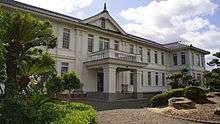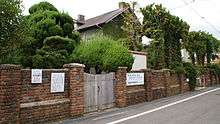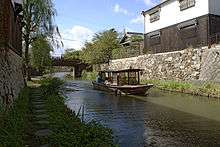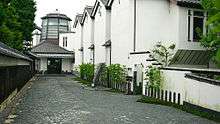Omihachiman
Get in
Get around

Take the north exit from the JR station, where there is a small tourist information office and a city bus terminal. All the major tourist attractions are some distance away in the older part of town near Lake Biwa. The tourist office will provide a guide map (in Japanese) outlining a walking tour of the main sites, each clearly identified on the map by image and number key. Many of the signs by the main attractions are bilingual in Japanese and English. The loop through the old town begins and ends near Hachiman Elementary School in Ikeda-cho, 25 min on foot or 5 min by bus down the main street to and from the station (Ekimae Ōdori, which becomes Obata-chō-dōri 小幡町通り). The basic walking tour covers 6 km and takes 1.5 hours on foot, perhaps 4 hours with stops included. An optional, 5-km detour to the scenic lakeside village on Sainoko ("West Lake" but east of the old town) would add an extra hour.
See



The old part of this city is practically an outdoor architectural museum, designated by the Japanese government as a national preservation district as well as an important cultural landscape. It was an important commercial center from at least the early Edo Period, when prosperous Omi merchants controlled trade across Lake Biwa between the Kinki and Hokuriku regions (and up as far as Matsumae in Hokkaido). From 1905 until 1964, it was the home base of William Merrell Vories, a missionary, educator, entrepreneur, and architect who designed many early Western-style buildings in major Japanese cities. Because Omihachiman was not bombed during World War II, it preserves many fine old merchant houses from the Edo Period as well as many unusual Western-style buildings that Vories designed during the Meiji and Taisho eras.
- Ikeda-cho Western Houses Street (池田町洋館街). The Western Colonial-style houses behind the long brick wall along this street were designed by Vories during the Taisho Era (1912–1924). They are not open to the public but may be viewed from the street. A bilingual sign on the wall explains more about the illustrious architectural career of Vories, who married a Japanese noblewoman and became a Japanese citizen in 1941.
- Obata-cho and merchant mansions (小幡町、新町通り), Obata-cho and Shinmachi-dori (Straight down Obatacho-dori 7 stoplights from JR Omihachiman Station). The Visitor Center at Obata-cho offers parking and leads to the rich merchant mansions that line both sides of Shinmachi Street between Obata-cho and the Hachiman Canal. Bilingual signs in Japanese and English name some of the rich merchants and note their far-reaching commercial activities throughout the Edo Period.
- Hachiman-bori Canal Walk (八幡堀遊歩道). The canal was once a castle moat, but later served to carry heavy cargo, especially the roof tiles for which the city was famous, across the lake to larger cities. Stone walkways beside it give a vivid sense of what the architecture of the town looked like hundreds of years ago. The walkway is a wonderful place to view cherry blossoms in the spring, and to hear cicadas buzzing in the summer. It is the city's signature location, depicted on the cover of its guide map and on its manhole covers.
- Kawara Museum (かわらミュージアム), ☎ +81 748-33-6633, fax: +81 748-33-4608, e-mail: h-kawara@80000.jp. This tile museum on a picturesque corner of the canal shows the history of Omihachiman roof tiles and the manufacturing process. It also displays images of the city, including a large 3-dimensional photograph of the roof tiles in Shincho-dori. ¥300 adult, ¥200 child.
- Mount Hachiman
- Hachiman-yama Ropeway
- Hachiman-yama Castle Ruins
- William Merrell Vories Museum
Do
Buy
Eat

- Sennari-tei. Local Omi beef specialist.
- Morishima. Local Omi beef specialist.
Drink
Sleep
Connect
Go next
| Routes through Omihachiman |
| Kyoto ← Otsu ← | W |
→ Hikone → Maibara |